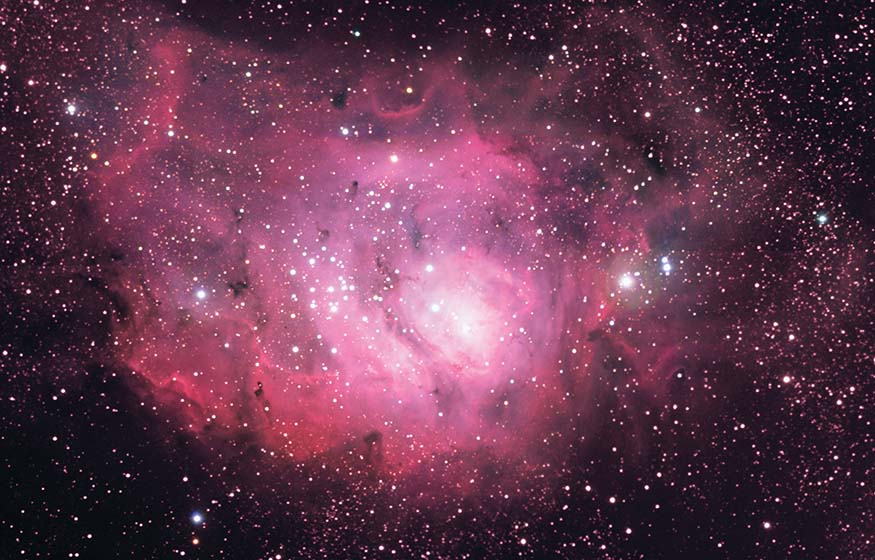
BEAUTY: 
BRAGGING RIGHTS: A beautiful sight
HOW EASY IS IT TO SEE? Best with binoculars
BEST TIME TO SEE IT: Summer (in Sagittarius)
TYPE: Diffuse Nebula
DISCOVERED: Before 1654 by Giovanni Hodierna
When it comes to astronomy, location matters. Charles Messier observed this object from Paris (49 degrees latitude), which means he saw it obscured by the haze of the horizon. He noted a dim, unimpressive nebula, but otherwise focused on the nearby cluster of stars. He entered both into his famous Messier catalog at number 8.
But from more southern climes, Messier 8—also known as the Lagoon Nebula—is spectacular. It is one of my favorite nebulae, surpassed in North American skies only by the Orion Nebula.
Physically, the Lagoon Nebula is several times larger than the Orion Nebula, but the Orion Nebula is much closer to Earth, so it appears larger and brighter. I can only wonder what such a magnificent nebula would look like if the solar system were closer to it. Once again, location matters.
While not as bright as the Orion Nebula, Messier 8 is still easy to spot. Wait for a moonless night in summer and look for the teapot of Sagittarius above the southern horizon. Scan with binoculars above the teapot and you’ll see a wealth of wondrous objects: nebulae, clusters, and uncountable stars. The brightest of these will be a small rectangular cloud filled with bright stars—that’s the Lagoon Nebula.
WHAT YOU MIGHT SEE THROUGH AMATEUR EQUIPMENT
Dark skies away from light pollution ensure the best view, but you’ll be able to see this beautiful nebula from any suburban backyard. Of course, if you’re as far north as Maine or Paris, you’ll need an unobstructed view of the southern horizon.
You can see plenty of detail with binoculars alone, but a small or medium telescope at low power can reveal much more. Larger telescopes can’t always fit the whole nebula, but they reveal more subtle detail at its central core.
As with other faint objects, do not expect to see any color in the nebula.
The dark lane. The most obvious feature of the Lagoon nebula is probably the dark lane that splits it into two parts. Agnes M. Clerke wrote about it in The System of the Stars, her 1890 popular astronomy book, and referred to the lane as a “lagoon.” The name stuck.
With better instruments than those available to her, we can see that this is more like a channel than a lagoon: a thick line of dark dust obscuring the brighter gas beneath. Through a small telescope you can see hints of other dust clouds, threading through the nebula like vines.
The bright folds. The dust clouds give shape to the bright nebula, making it look like folds in satin. Use averted vision to see the full extent of the nebula and to pick up the wealth of detail.
The cluster. Even without a nebula, the tight cluster of bright stars would be beautiful and noteworthy. They are the brightest cluster of stars in Sagittarius and they have their own designation: NGC 6530. Like the Pleiades, these stars were born in the Lagoon Nebula and will eventually drift away, possibly eliminating the rest of the nebula in the process.
The hourglass. The core of the nebula is on the opposite side of the dark lane from the cluster. At medium-high magnification, you might see that the brightest patch is shaped like an hourglass and surrounded by darker nebulae. You’re looking at the heart of the nebula, where newborn stars have burned away their dark shroud. The “hourglass” is more like a hole punched through the dark nebula, letting us peer into the star-factory inside.
SAGITTARIUS REGION IN SUMMER; 30-DEGREE FIELD OF VIEW